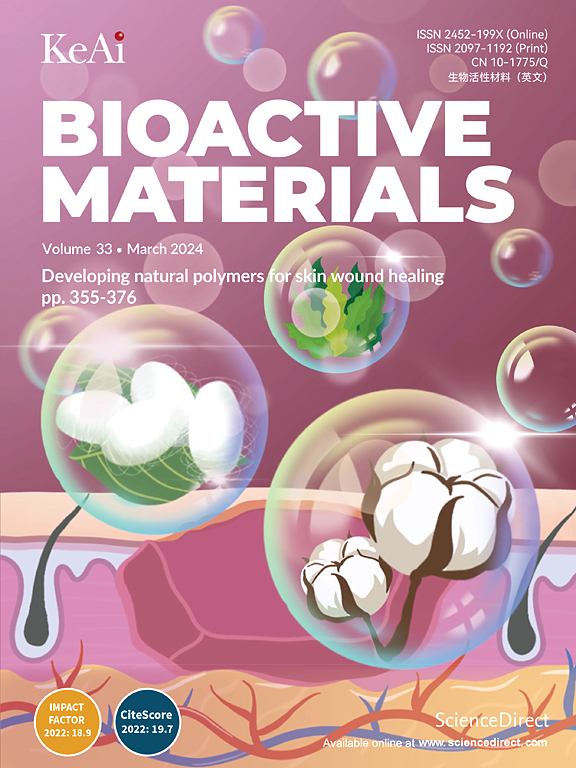Janus piezoelectric adhesives regulate macrophage TRPV1/Ca2+/cAMP axis to stimulate tendon-to-bone healing by multi-omics analysis
IF 18
1区 医学
Q1 ENGINEERING, BIOMEDICAL
引用次数: 0
Abstract
Piezoelectric stimulation has garnered substantial interest as a promising strategy for tissue regeneration. However, studies investigating its impact on tendon-to-bone healing characterized by fibrocartilage remain scarce. Moreover, there are considerable technical challenges in achieving minimally invasive application of piezoelectric stimulation on the irregular tendon-to-bone interface. Herein, we developed Janus asymmetric piezoelectric adhesives by assembling adhesive hydrogel (GAN) and non-adhesive hydrogel (GM) on each side of piezoelectric poly (L-lactic acid) nanofiber. Piezoelectric adhesives exhibited superior anti-inflammatory effects both in vitro and ex vivo. Notably, the transient receptor potential (TRP) ion channels, a class of versatile signaling molecules, are closely associated with the regulation of inflammation. This study demonstrated that piezoelectric stimulation promoted Ca2+ influx through the activation of transient receptor potential vanilloid 1 (TRPV1), further enhancing cAMP signaling pathway in macrophages by RNA sequencing. Additionally, in vivo proteomic analysis revealed Arachidonic acid metabolism and TNF-α signaling pathway downregulation and VEGF signaling pathway upregulation in a rat rotator cuff repair model. Piezoelectric adhesives ultimately achieved inflammation alleviation, angiogenesis enhancement, and fibrocartilage regeneration promotion, improving the biomechanical strength of the enthesis. This study elucidated the mechanism by which piezoelectric stimulation regulated tendon-to-bone healing through multi-omics analysis. The piezoelectric adhesives hold promise as a convenient and effective strategy for enhancing tendon-to-bone healing in clinical practice.

通过多组学分析,Janus压电胶粘剂调节巨噬细胞TRPV1/Ca2+/cAMP轴刺激肌腱-骨愈合
压电刺激作为一种有前途的组织再生策略已经引起了人们的极大兴趣。然而,关于其对以纤维软骨为特征的肌腱-骨愈合影响的研究仍然很少。此外,在不规则肌腱-骨界面上实现压电刺激的微创应用存在相当大的技术挑战。本文通过在聚l -乳酸纳米纤维的两侧分别组装粘接水凝胶(GAN)和非粘接水凝胶(GM),研制了Janus非对称压电胶粘剂。压电胶粘剂在体外和离体均表现出良好的抗炎作用。值得注意的是,瞬态受体电位(TRP)离子通道是一类多功能信号分子,与炎症的调节密切相关。本研究通过RNA测序证实,压电刺激通过激活瞬时受体电位香兰素1 (transient receptor potential vanilloid 1, TRPV1)促进Ca2+内流,进一步增强巨噬细胞的cAMP信号通路。此外,体内蛋白质组学分析显示,大鼠肩袖修复模型中花生四烯酸代谢和TNF-α信号通路下调,VEGF信号通路上调。压电胶粘剂最终实现了消炎、增强血管生成、促进纤维软骨再生,提高了假体的生物力学强度。本研究通过多组学分析阐明了压电刺激调节肌腱-骨愈合的机制。在临床实践中,压电胶粘剂有望成为一种方便有效的肌腱-骨愈合策略。
本文章由计算机程序翻译,如有差异,请以英文原文为准。
求助全文
约1分钟内获得全文
求助全文
来源期刊

Bioactive Materials
Biochemistry, Genetics and Molecular Biology-Biotechnology
CiteScore
28.00
自引率
6.30%
发文量
436
审稿时长
20 days
期刊介绍:
Bioactive Materials is a peer-reviewed research publication that focuses on advancements in bioactive materials. The journal accepts research papers, reviews, and rapid communications in the field of next-generation biomaterials that interact with cells, tissues, and organs in various living organisms.
The primary goal of Bioactive Materials is to promote the science and engineering of biomaterials that exhibit adaptiveness to the biological environment. These materials are specifically designed to stimulate or direct appropriate cell and tissue responses or regulate interactions with microorganisms.
The journal covers a wide range of bioactive materials, including those that are engineered or designed in terms of their physical form (e.g. particulate, fiber), topology (e.g. porosity, surface roughness), or dimensions (ranging from macro to nano-scales). Contributions are sought from the following categories of bioactive materials:
Bioactive metals and alloys
Bioactive inorganics: ceramics, glasses, and carbon-based materials
Bioactive polymers and gels
Bioactive materials derived from natural sources
Bioactive composites
These materials find applications in human and veterinary medicine, such as implants, tissue engineering scaffolds, cell/drug/gene carriers, as well as imaging and sensing devices.
 求助内容:
求助内容: 应助结果提醒方式:
应助结果提醒方式:


